2.3.1: Exercises 2.3
- Page ID
- 65825
In Exercises \(\PageIndex{1}\) - \(\PageIndex{4}\), vectors \(\vec{x}\) and \(\vec{y}\) are given. Sketch \(\vec{x}\), \(\vec{y}\), \(\vec{x}+\vec{y}\), and \(\vec{x}-\vec{y}\) on the same Cartesian axes.
\(\vec{x}=\left[\begin{array}{c}{1}\\{1}\end{array}\right],\quad\vec{y}=\left[\begin{array}{c}{-2}\\{3}\end{array}\right]\)
- Answer
-
\(\vec{x}+\vec{y}=\left[\begin{array}{c}{-1}\\{4}\end{array}\right],\quad\vec{x}-\vec{y}=\left[\begin{array}{c}{3}\\{-2}\end{array}\right]\)
Sketches will vary depending on choice of origin of each vector.
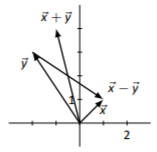
Figure \(\PageIndex{1}\)
\(\vec{x}=\left[\begin{array}{c}{3}\\{1}\end{array}\right],\quad\vec{y}=\left[\begin{array}{c}{1}\\{-2}\end{array}\right]\)
- Answer
-
\(\vec{x}+\vec{y}=\left[\begin{array}{c}{4}\\{-1}\end{array}\right],\quad\vec{x}-\vec{y}=\left[\begin{array}{c}{2}\\{3}\end{array}\right]\)
Sketches will vary depending on choice of origin of each vector.
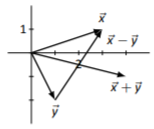
Figure \(\PageIndex{2}\)
\(\vec{x}=\left[\begin{array}{c}{-1}\\{1}\end{array}\right],\quad\vec{y}=\left[\begin{array}{c}{-2}\\{2}\end{array}\right]\)
- Answer
-
\(\vec{x}+\vec{y}=\left[\begin{array}{c}{-3}\\{3}\end{array}\right],\quad\vec{x}-\vec{y}=\left[\begin{array}{c}{1}\\{-1}\end{array}\right]\)
Sketches will vary depending on choice of origin of each vector.
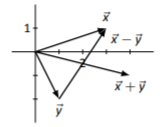
Figure \(\PageIndex{3}\)
\(\vec{x}=\left[\begin{array}{c}{2}\\{0}\end{array}\right],\quad\vec{y}=\left[\begin{array}{c}{1}\\{3}\end{array}\right]\)
- Answer
-
\(\vec{x}+\vec{y}=\left[\begin{array}{c}{3}\\{3}\end{array}\right],\quad\vec{x}-\vec{y}=\left[\begin{array}{c}{1}\\{-3}\end{array}\right]\)
Sketches will vary depending on choice of origin of each vector.
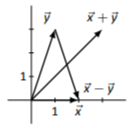
Figure \(\PageIndex{4}\)
In Exercises \(\PageIndex{5}\) – \(\PageIndex{8}\), vectors \(\vec{x}\) and \(\vec{y}\) are drawn. Sketch \(2\vec{x}-\vec{y}\), \(\vec{x}+\vec{y}\), \(\vec{x}-\vec{y}\) on the same Cartesian axes.
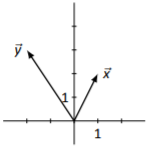
Figure \(\PageIndex{5}\)
- Answer
-
Sketches will vary depending on choice of origin of each vector.
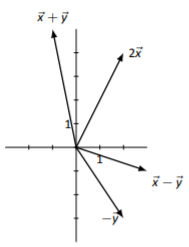
Figure \(\PageIndex{6}\)
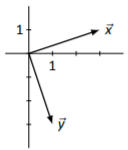
Figure \(\PageIndex{7}\)
- Answer
-
Sketches will vary depending on choice of origin of each vector.

Figure \(\PageIndex{8}\)
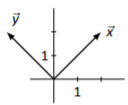
Figure \(\PageIndex{9}\)
- Answer
-
Sketches will vary depending on choice of origin of each vector.
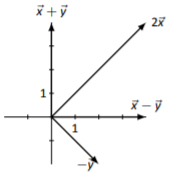
Figure \(\PageIndex{10}\)
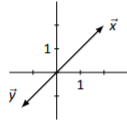
Figure \(\PageIndex{11}\)
- Answer
-
Sketches will vary depending on choice of origin of each vector.
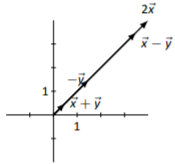
Figure \(\PageIndex{12}\)
In Exercises \(\PageIndex{9}\) - \(\PageIndex{12}\), a vector \(\vec{x}\) and a scalar \(a\) are given. Using Definition Vector Length compute the lengths of \(\vec{x}\) and \(a\vec{x}\), then compare these lengths.
\(\vec{x}=\left[\begin{array}{c}{2}\\{1}\end{array}\right],\quad a=3\)
- Answer
-
\(||\vec{x}||=\sqrt{5};\: ||a\vec{x}||=\sqrt{45}=3\sqrt{5}\). The vector \(a\vec{x}\) is \(3\) times as long as \(\vec{x}\).
\(\vec{x}=\left[\begin{array}{c}{4}\\{7}\end{array}\right],\quad a=-2\)
- Answer
-
\(||\vec{x}||=\sqrt{65};\: ||a\vec{x}||=\sqrt{260}=2\sqrt{65}\). The vector \(a\vec{x}\) is \(2\) times as long as \(\vec{x}\).
\(\vec{x}=\left[\begin{array}{c}{-3}\\{5}\end{array}\right],\quad a=-1\)
- Answer
-
\(||\vec{x}||=\sqrt{34};\: ||a\vec{x}||=\sqrt{34}\). The vectors \(a\vec{x}\) and \(\vec{x}\) are the same length (they just point in opposite directions).
\(\vec{x}=\left[\begin{array}{c}{3}\\{-9}\end{array}\right],\quad a=\frac{1}{3}\)
- Answer
-
\(||\vec{x}||=\sqrt{90}=3\sqrt{10};\: ||a\vec{x}||=\sqrt{10}\). The vector \(a\vec{x}\) is one-third the length of \(\vec{x}\); equivalently, \(\vec{x}\) is \(3\) times as long as \(a\vec{x}\).
Four pairs of vectors \(\vec{x}\) and \(\vec{y}\) are given below. For each pair, compute \(||\vec{x}||\), \(||\vec{y}||\), and \(||\vec{x}+\vec{y}||\). Use this information to answer: Is it always, sometimes, or never true that \(||\vec{x}||+||\vec{y}||=||\vec{x}+\vec{y}||\)? If it always or never true, explain why. If it is sometimes true, explain when it is true.
- \(\vec{x}=\left[\begin{array}{c}{1}\\{1}\end{array}\right],\quad\vec{y}=\left[\begin{array}{c}{2}\\{3}\end{array}\right]\)
- \(\vec{x}=\left[\begin{array}{c}{1}\\{-2}\end{array}\right],\quad\vec{y}=\left[\begin{array}{c}{3}\\{-6}\end{array}\right]\)
- \(\vec{x}=\left[\begin{array}{c}{-1}\\{3}\end{array}\right],\quad\vec{y}=\left[\begin{array}{c}{2}\\{5}\end{array}\right]\)
- \(\vec{x}=\left[\begin{array}{c}{2}\\{1}\end{array}\right],\quad\vec{y}=\left[\begin{array}{c}{-4}\\{-2}\end{array}\right]\)
- Answer
-
- \(||\vec{x}||=\sqrt{2};\: ||\vec{y}||=\sqrt{13};\: ||\vec{x}+\vec{y}||=5\).
- \(||\vec{x}||=\sqrt{5};\: ||\vec{y}||=3\sqrt{5};\: ||\vec{x}+\vec{y}||=4\sqrt{5}\).
- \(||\vec{x}||=\sqrt{10};\: ||\vec{y}||=\sqrt{29};\: ||\vec{x}+\vec{y}||=\sqrt{65}\).
- \(||\vec{x}||=\sqrt{5};\: ||\vec{y}||=2\sqrt{5};\: ||\vec{x}+\vec{y}||=\sqrt{5}\).
The equality holds sometimes; only when \(\vec{x}\) and \(\vec{y}\) point along the same line, in the same direction.
In Exercises \(\PageIndex{14}\) - \(\PageIndex{17}\), a matrix \(A\) is given. Sketch \(\vec{x}\), \(\vec{y}\), \(A\vec{x}\) and \(A\vec{y}\) on the same Cartesian axes, where
\[\vec{x}=\left[\begin{array}{c}{1}\\{1}\end{array}\right]\quad\text{and}\quad\vec{y}=\left[\begin{array}{c}{-1}\\{2}\end{array}\right]\nonumber \]
\(A=\left[\begin{array}{cc}{1}&{-1}\\{2}&{3}\end{array}\right]\)
- Answer
-
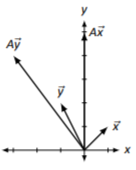
Figure \(\PageIndex{13}\)
\(A=\left[\begin{array}{cc}{2}&{0}\\{-1}&{3}\end{array}\right]\)
- Answer
-
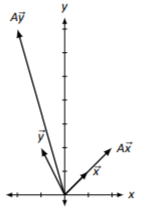
Figure \(\PageIndex{14}\)
\(A=\left[\begin{array}{cc}{1}&{1}\\{1}&{1}\end{array}\right]\)
- Answer
-
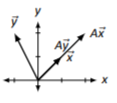
Figure \(\PageIndex{15}\)
\(A=\left[\begin{array}{cc}{1}&{2}\\{-1}&{-2}\end{array}\right]\)
- Answer
-
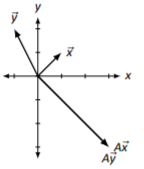
Figure \(\PageIndex{16}\)

